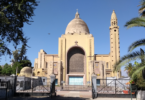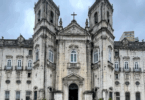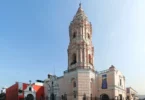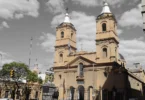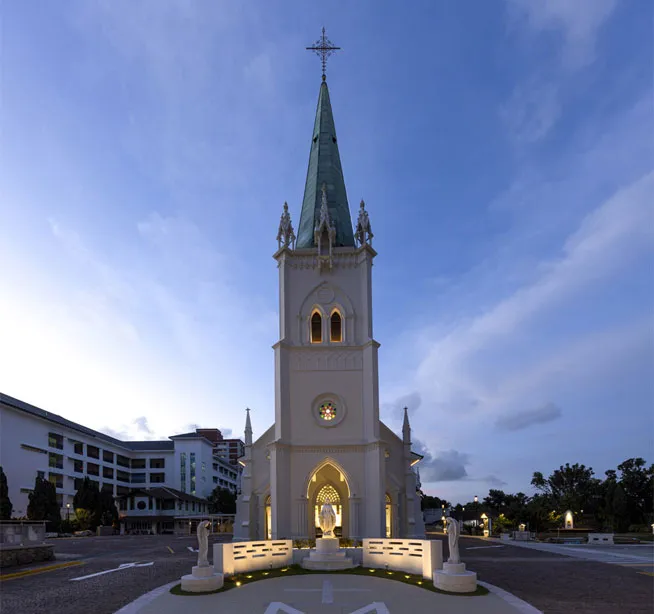
Introduction
The Church of the Nativity of the Blessed Virgin Mary is a Roman Catholic church in Singapore. It is located in Hougang, the North-East Region of Singapore, and is within the Serangoon District.It is well known as the oldest Catholic church for the Teochew community in Serangoon. The Church of the Nativity of the Blessed Virgin Mary is one of the earliest Catholic churches built in the suburbs of Singapore. Over the years, the church has faithfully served the spiritual needs of the predominantly Teochew-speaking Catholics living in Hougang, which at a point in time outnumbered the non-Catholic community. It now stands as a living testament not only to the spread of Catholicism, but also to the many contributions of Catholic missionaries in nineteenth-century Singapore.
The Church of the Nativity of the Blessed Virgin Mary, commonly known as just the Church of the Nativity, is a Catholic church located at 1259 Upper Serangoon Road. In its beginnings during the 19th century, the church catered to the Teochew Catholic community, which comprised mainly farmers living in the Serangoon and Punggol areas. It now serves a multiracial community primarily in the Hougang housing estate. The gothic-style church was gazetted as a national monument in 2005.
The Church of the Nativity of the Blessed Virgin Mary is one of the earliest Catholic churches built in the suburbs of Singapore. Over the years, the church has faithfully served the spiritual needs of the predominantly Teochew-speaking Catholics living in Hougang, which at a point in time outnumbered the non-Catholic community. It now stands as a living testament not only to the spread of Catholicism, but also to the many contributions of Catholic missionaries in nineteenth-century Singapore.
The Church of the Nativity of the Blessed Virgin Mary (Chinese: 圣母圣诞堂) is a Roman Catholic church in Singapore. From a humble beginning as an attap chapel in 1853, the church was shifted multiple times before being located in its current location. The construction was completed in 1901 and underwent extension works in 1933 to accommodate larger number of people. Some of the unique features of the church is the Belfry Tower enclosing the bell and spire located at the top of the main church hall.It is one of the oldest Catholic churches for the Teochew community and the church has been gazetted as a national monument on 14 January 2005.
The Church of the Nativity of the Blessed Virgin Mary is the oldest place of worship in Hougang. Its history began in 1852 when Les Mission Étrangères de Paris (MEP) in France, sent its first missionary, Father Ambroise Maistre, to Hougang. Father Maistre obtained land from the colonial government and established an attap chapel in 1853 to serve the growing Teochew Catholic population. Initially known as the Church of St. Mary, the chapel was later reconstructed into a brick building.
In 1901, the mission built a new church designed in Neo-Gothic style, complete with pointed arches and ribbed vaults. Renamed Church of the Nativity of the Blessed Virgin Mary, the building saw further additions of side transepts, a sanctuary and a sacristy in 1933. The marble statue of the Immaculate Conception of Mary in front of the church was gifted by Sultan Ibrahim of Johor and the statue was received with a procession and blessed in 1946.
During World War II, the church served as a place of refuge for villagers. It also played an important role in providing education for the young in the area. Several prominent schools were started on the grounds of the church, including present-day Holy Innocents’ High School, Montfort Junior and Secondary School, and CHIJ Our Lady of the Nativity.
In 2005, the church was gazetted as a National Monument. Today, the strong historical links between the Teochew community and the church are still evident in the Teochew mass held by the church every week.
The history of the church began with the erection of an attap chapel in 1853 by a priest, Ambrose Maistre, on land that he had obtained from the government and with the help of a donation from a man named De Souza. Maistre reserved some land for the building of a presbytery and a school, and distributed the remaining land to Catholics to form a settlement round the chapel. As the number of Catholics in the area grew, he replaced the attap chapel with a brick one and named it the Church of St Mary. However, the congregation continued to increase and the new parish priest, Jean Casimir Saleilles, set about building a new church. On 2 August 1898, the foundation stone for the new church was blessed and laid by Bishop Charles Bourdon near the existing one.4 The size of this new building was 128 ft long by 46 ft wide, and its height, including the cross, was 152 ft.
Saleilles not only oversaw the construction, but was personally involved in carrying it out. Besides unloading 300-pound barrels of cement from the cart, he was also responsible for raising the new bell to the belfry, as the workers were unable to do so. The church was blessed and opened by Bishop René Fée on 8 December 1901, the Feast of the Immaculate Conception of the Blessed Virgin Mary. By 1931, the size of the congregation had grown to about 2,700, and the parish priest, Edward Becheras, started making plans for the extension of the church. A sanctuary and a sacristy were added in 1933. This more than doubled the size of the edifice, which was first built in 1901.
The growth in the number of parishioners over the years led the parish priest at the time, Father Hippolyte Berthold, to build a second church in nearby Sengkang to supplement the existing church. The new parish, the Church of St Anne, was blessed and opened in 1963.8 The Catholic settlement established by the first parish priest, Maistre, had already been replaced by public housing flats when the church celebrated its 160th anniversary in 2012, and it continues to serve parishioners in the area today. The only church in Singapore to offer a mass in Teochow, the Church of the Nativity of the Blessed Virgin Mary was founded in 1898 to foster ties between Catholics and the Teochew community in the country. Having played a prominent role in educating the poor masses, the church stands attached to several schools today. Known for educating an outstanding number of priests, it was accorded recognition as a ‘national monument’ in 2005.
The site of the church had been, historically, a busy marketplace between the St. Frol’s (later Saviour’s) Gate of the Moscow Kremlin and the outlying posad. The centre of the marketplace was marked by the Trinity Church, built of the same white stone as the Kremlin of Dmitry Donskoy (1366-68) and its cathedrals. Tsar Ivan IV marked every victory of the Russo-Kazan War by erecting a wooden memorial church next to the walls of Trinity Church; by the end of his Astrakhan campaign, it was shrouded within a cluster of seven wooden churches. According to the sketchy report in Nikon’s Chronicle, in the autumn of 1554 Ivan ordered construction of the wooden Church of Intercession on the same site, “on the moat”. One year later, Ivan ordered construction of a new stone cathedral on the site of Trinity Church that would commemorate his campaigns. Dedication of a church to a military victory was “a major innovation” for Muscovy. The placement of the church outside of the Kremlin walls was a political statement in favour of posad commoners and against hereditary boyars.
Chronists clearly identified the new building as Trinity Church, after its easternmost sanctuary; the status of “sobor” (large assembly church) has not been bestowed on it yet: In the same year, through the will of czar and lord and grand prince Ivan began making the pledged church, as he promised for the capture of Kazan: Trinity and Intercession and seven sanctuaries, also called “on the moat”. And the builder was Barma with company.
The identity of the architect is unknown. Tradition held that the church was built by two architects, Barma and Postnik: the official Russian cultural heritage register lists “Barma and Postnik Yakovlev”. Researchers proposed that both names refer to the same person, Postnik Yakovlev or, alternatively, Ivan Yakovlevich Barma (Varfolomey). Legend held that Ivan blinded the architect so that he could not re-create the masterpiece elsewhere, although the real Postnik Yakovlev remained active at least throughout the 1560s. There is evidence that construction involved stonemasons from Pskov and German lands.
Construction, 1898–1901
The present building of the church was commissioned to be built in 1898 to cater to the burgeoning Catholic community in the district by Father Jean Casimir Saleilles, parish priest from 1881 to 1911. It was designed in a neo-Gothic style by French priest Father Charles Benedict Nain, and could accommodate around 650 parishioners. Located at the junction of 73/4 milestones Upper Serangoon Road and Punggol Road (known as Hougang Ave 8 today), construction was completed in 1901. Officially blessed on 8 December 1901 by Bishop Rene Michel-Marie Fee, the feast day of the Immaculate Conception of the Blessed Virgin Mary, the church was renamed Church of the Nativity of the Blessed Virgin Mary.
Architecture of Church of the Nativity of the Blessed Virgin Mary
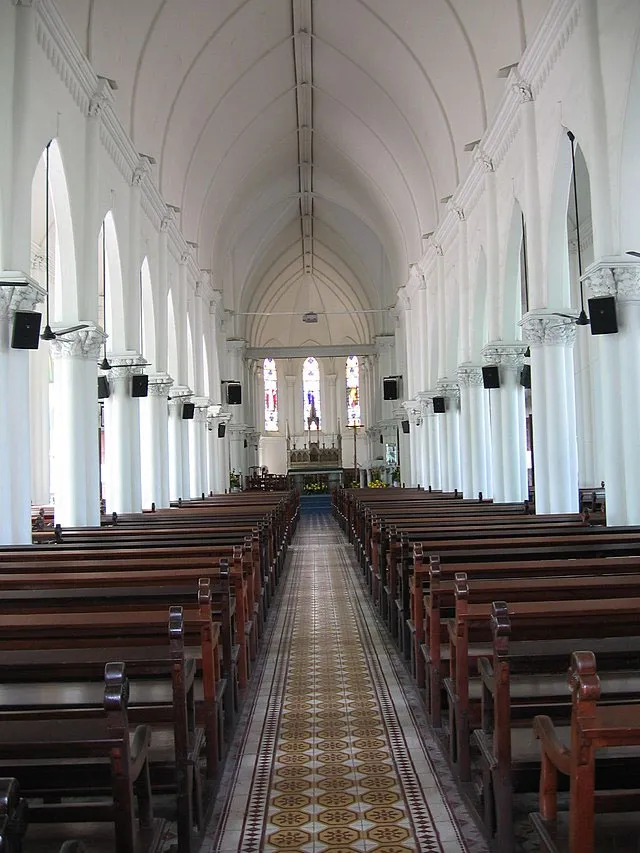
Architectural Design: Neo-Gothic Style
So beautiful European style church in Singapore.. the Grotto of Mother Mary infront of church invites many faithful to come and pray Rosary . We can do stations of the Cross as well in the compound which have 14 beautiful stations which we can walk along and meditate.. a true spiritual Oasis indeed. The Church of the Nativity of the Blessed Virgin Mary is one of several examples of Neo-Gothic church architecture adapted for the tropics. The marble statue of Mary in the foreground is interestingly a gift from Sultan Ibrahim of Johor in 1946.
Churches are always places where I find a great sense of peace in and in the quiet of the Saturday morning I was there, it was just that I found in stepping through the huge doors at the entrance, finding the interior bathed in the soft natural light of the morning streaming through the generous openings typically found in the tropically adapted Neo-Gothic church design. The church both internally and externally is a visual treat. On the insides, its high vaulted ceiling is accompanied by the rows of arches which would typically line the nave. Focus is drawn towards the Sanctuary bathed in the coloured light of stained glass a building such as this would look bare without.
The interior with its adornments and furnishings, is a wonderful reminder of how Catholic churches used to be. The dark stained carved wooden pews is a rare find now with most churches around having been built in more modern times. The walls of the transept are where the statues representing the various saints are placed. These are typical of most Catholic churches and in the older ones it would be in purpose built niches as the ones found in this church in which the statues are placed. The windows, which can be opened, provide not just natural ventilation, but also light – typical of architecture adapted for the tropically environment which we do not see in modern buildings built to be air-conditioned.
Exterior
This is a 2008 photograph of the Church of the Nativity of the Blessed Virgin Mary at Upper Serangoon Road. Constructed in 1901, the church features Gothic architecture, with its typical use of pointed arches in windows and doorways. It was gazetted as a national monument on 14 January 2005. Title devised by Library staff.
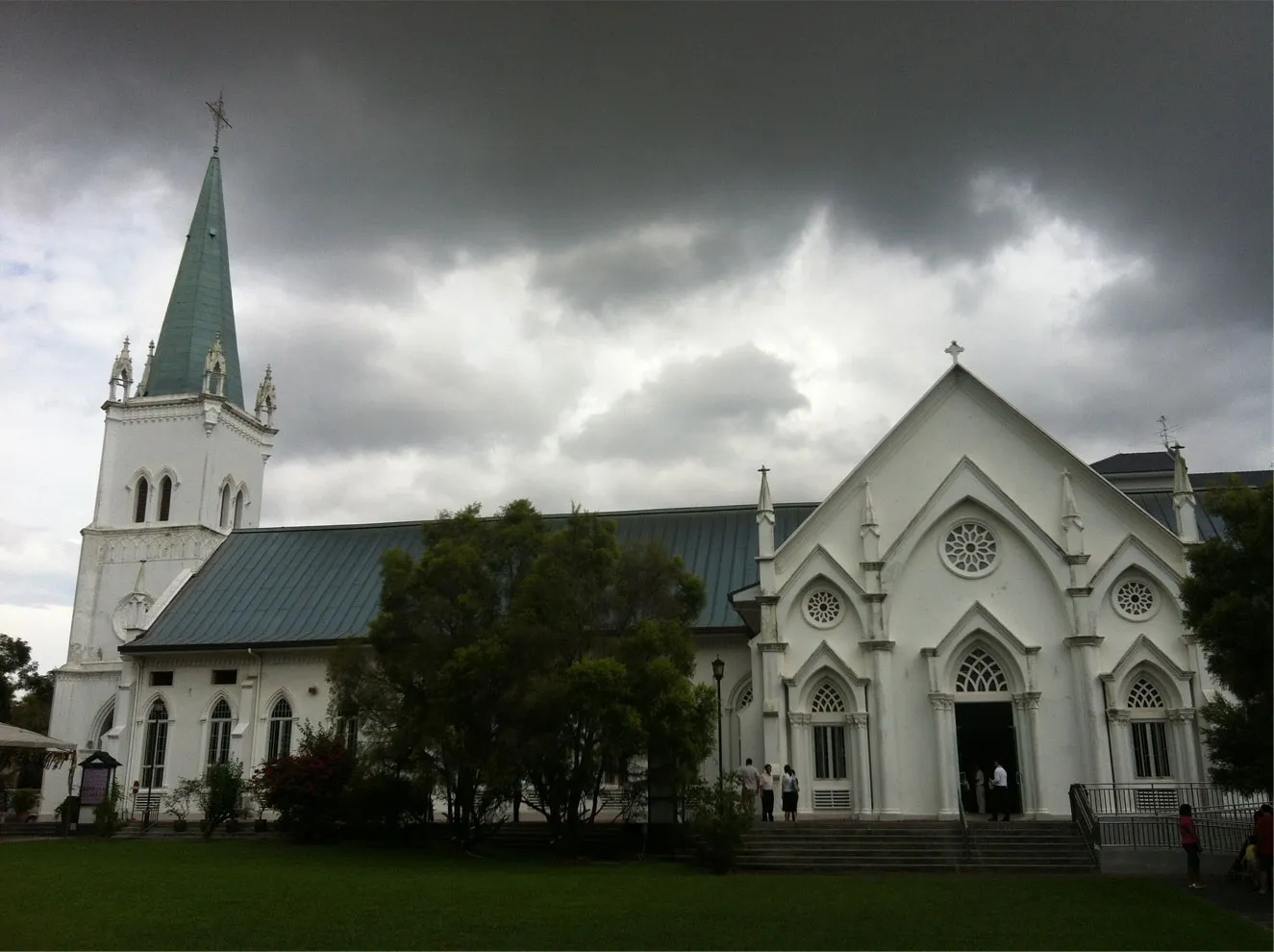
Architectural features
Built in a neo-Gothic style, the church was initially shaped rectangular. After the addition of transepts in the 1930s, the church now takes on the form of a Latin cross. At the front end of the church stands a belfry tower capped with a spire and ornate brass cross. Rose windows decorate the façade of both transepts as well as the belfry. To the left of the main marble altar at the centre of the church stands the Chapel of the Sacred Heart of Jesus, while the Chapel of the Immaculate Conception stands to the right. Statues of saints are enshrined in niches on the walls of the side aisles. Behind the altars are five stained-glass windows depicting, from left to right, St Francis Xavier, the Sacred Heart of Jesus, the Immaculate Conception, St Joseph, and St Therese de Lisieux respectively. The nave also holds the tombs of five former priests of the Church. In the foreground of the entrance of the church stands an iconic statue – “The Immaculate Conception of Mary”. This marble statue was presented to the church by Sultan Ibrahim of Johor as a token of his long-standing friendship with Reverend Father Francis Chan (later installed as Bishop of Penang), parish priest of the church between 1946 and 1955.
Architecture and Furnishings
Designed in the Neo-Gothic style, the Church of the Blessed Virgin Mary initially had a simple rectangular plan. When the transepts were added, the ecclesiastical edifice took on a cruciform plan, similar to that of the Cathedral of the Good Shepherd and Saint Joseph’s Church in town. Rising above the entrance porch is the towering belfry, which is crowned with a large, ornate brass cross. Decorative fanlights with simple Gothic tracery top the many lancet-shaped doors and bay windows around the church, ensuring that the interior is well ventilated. The large doors with herringbone designs are made of heavy timber, while the lower windows have timber-framed, double-leaf louvred shutters. There are also rose windows on the façades of the north and south transepts, and also on the belfry.
Inside the church, the central aisle in the nave is flanked by two rows of stately Corinthian columns. Lancet-shaped niches are carved into the walls on the side aisles, where statues of saints are enshrined. There are also several stained-glass windows around the church. Behind the Gothic high altar are five beautiful windows depicting (from left to right) Saint Francis Xavier, the Sacred Heart of Jesus, the Immaculate Conception, Saint Joseph, and Saint Teresa of the Child Jesus. On either side of the sanctuary is a chapel, dedicated to the Sacred Heart of Jesus and the Immaculate Conception respectively. The tombs of five priests – including that of Father Saleilles – can also be found in the nave.
The iconic statue of the Blessed Virgin Mary in front of the church’s main entrance has a particularly interesting provenance. Sultan Ibrahim of Johor had generously presented the marble statue to the church as a token of his friendship with Reverend Father (later, Bishop) Francis Chan, who was then the parish priest of the church between 1946 and 1955.
Expansion, 1933
However, by the 1930s, the church had to be expanded again to accommodate the growing parish; general attendance at Mass rose to 1350. The size of the original church was thus doubled with the addition of the side transepts, the sanctuary and sacristy in 1933. Widespread activities of secret societies plaguing the area between the 1850s and 1920s meant that settlers had to seek a protector. The church soon became that protector since she had a huge congregation and “church members would stand up for one another when conflicts with outsiders arose”. Such protection would continue throughout the Japanese Occupation when the church served as a sanctuary where parishioners could hide from the Japanese.
Education
The church also played a prominent role in offering education and religious instruction to parishioners and settlers in Hougang. Tao Nan School was founded as a Chinese medium school in 1892, and is known as Holy Innocents’ High School today. Holy Innocents’ English School was then established as a parish school in 1916 to the left of the church premises. Later taken over by the Gabrielite Brothers and renamed Monfort’s School in 1936. After a split by educational stages in 1992, Monfort Junior School and Monfort Secondary School still stand in Hougang today. Holy Innocents’ Chinese Girls’ School was founded in 1932.It is known as Holy Innocents’ Primary School today after it amalgamated with the primary section of Holy Innocents’ High School in 1985. Convent of the Holy Infant Jesus (CHIJ) Punggol was established in 1957 and was renamed CHIJ Our Lady of the Nativity in 2001.
The St Francis Xavier Minor Seminary was also built opposite the church in 1924 to provide instruction to potential candidates to the priesthood. It still stands at its original location, alongside the Catholic Spirituality Centre.
Vernacular Masses
Vatican II introduced the use of vernacular languages in the liturgy. In Singapore, English Masses first began in 1965 and Mandarin ones in 1970. Teochew Masses were first offered in the Nativity Church in 1971 on Pentecost Sunday. Till this date, the Nativity Church remains the only Catholic church in Singapore that offers Mass in Teochew.
Ongoing Activities
The church serves approximately 6000 parishioners today. Another 1200 parishioners attend Korean Mass ever since the Korean Catholic community has permanently shifted and been based here in 2012. Besides religious services, the church also began running the Nativity Church Kindergarten for Pre-Nursery, Nursery, K1 and K2 children in 2003. An elderly daycare facility, Senior Connection @ Nativity, was also recently established in 2016 to provide daycare services for elderly in the district, regardless of their faith.
Matthew
Responding to the then impending economic crisis, Father Henry Siew, parish priest, initiated the establishment of Matthew 25, a soup kitchen, in April 2008. The name of the soup kitchen was derived from verse 25 of Matthew, where Jesus says, “In truth, I tell you, in so far as you did this to one of the least of my brothers, you did it to me.” Matthew 25 offers free breakfast and lunch to the less privileged, regardless of their race, age, or religion. Other than serving approximately 140 residents who walk into the church premises daily, volunteers also deliver about another 190 packed meals to Senior Activity Centres in the vicinity. Free haircuts are also offered every second Tuesday of the month at the Church by the Matthew 25 ministry.
Priests
- Rev. Fr Kenson Koh (Parish Priest)
- Rev. Fr Justin Yip (Assistant Parish Priest)
- Rev. Fr Emmanuel Teo, OCD
Music
From humble beginnings, the music community of the Church strengthened and grown through the years. Today, the Church holds a Yamaha Electone STAGEA and a KORG Clavinova. A distinctive feature in Singapore is the high ceilings of the church which creates an acoustic hall ambience. Most musicians of the church are self-learned musicians and have been serving in the Church for years. Musical knowledge is a passed down through the generations. The organist for the Salve Regina Choir, Terence Teo, also composed music for famous artists like Sammi Cheng as well as Fei Yu-ching.
Choirs
- There are five English choirs and other few Chinese, Teochew and Korean choirs.
- The five English choirs:
- Holy Spirit Choir (Sunday, 5.30pm)
- Salve Regina Choir (Saturday, 6.00pm)
- Seraphim Choir (Sunday, 9.15am)
- St Hilary’s Choir (Sunday, 11.00am)
- St Thomas Aquinas Choir (Sunday, 7.00am)
Church of the Nativity of the Blessed Virgin Mary Today
Next to the church compound is CHIJ Our Lady of the Nativity (previously known as CHIJ Ponggol), a branch of the Convent of the Holy Infant Jesus, which is Singapore’s oldest Catholic educational institution for girls. The school is under the pastoral care of the church. The Church of the Nativity of the Blessed Virgin Mary offers daily Masses in English, as well as additional Sunday Masses in Teochew and Mandarin for Chinese Catholics. Regular Masses are also celebrated in Korean for Singapore’s Korean Catholic community, which also calls the church their spiritual home.
Annual Feast Day
Feast day: 08 September
The annual feast day of The Church of the Nativity of the Blessed Virgin Mary Singapore is celebrated on September 08 each year.
Mass Timing
Week Days:
Monday to Friday: 6:00 PM
Weekend:
Saturday 6:00 PM
Sunday 10:00 AM, 12:00 PM, 5:00 PM
Contact Info
1259 Upper Serangoon Rd,
Singapore 534795.
Phone No.
Phone: +65 6280 0980
Accommodations
Connectivities
Airway
The nearest airport to The Church of the Nativity of the Blessed Virgin Mary Singapore is, Singapore Changi Airport, 60 Airport Blvd., Singapore , which is just 17 min (12.1 km) via TPE away from the basilica.
Railway
The nearest railway to Church of the Nativity of the Blessed Virgin Mary Singapore, Smrt Trains Ltd, 300 Bishan Rd, Singapore , which is just 17 min (7.7 km) via Ang Mo Kio Ave 3 away from the basilica.


